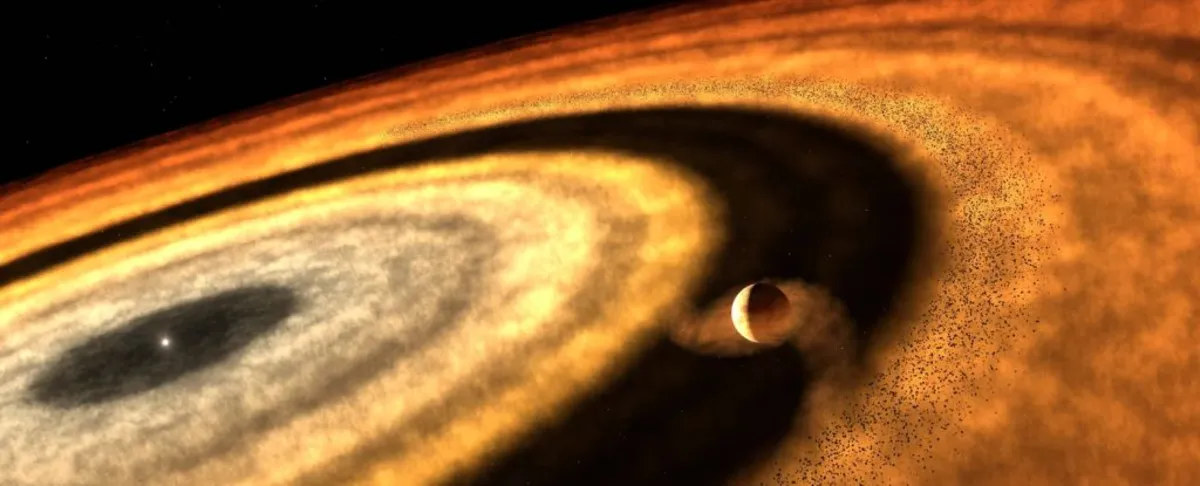
The tiny pebbles left over from a star's formation played a crucial role in the growth of one of the most bizarre worlds ever discovered: Tylos, also known as WASP-121b. This gas giant exoplanet, located approximately 880 light-years from Earth, orbits so close to its host star that its atmosphere is saturated with clouds of vaporized metal. Recent observations have revealed that Tylos was constructed from the dust and rocks that once circled its star in the early formative years of its solar system.
Using the James Webb Space Telescope (JWST), a research team led by astronomer Thomas Evans-Soma from the University of Newcastle in Australia has identified silicon monoxide—clouds of vaporized rock—in Tylos's atmosphere. This discovery, along with the detection of water, carbon monoxide, and methane, provides valuable insights into the planet's formation and material acquisition. The relative abundances of these molecules, particularly carbon, oxygen, and silicon, shed light on the processes that created this extraordinary exoplanet.
Tylos has a radius approximately 1.75 times that of Jupiter but a mass only 1.16 times greater. It orbits a yellow-white star named Dilmun, which is 1.5 times the radius of our Sun. Tylos completes this orbit in just 30 hours, placing it in an incredibly close proximity to its star. The intense heat from Dilmun causes Tylos's atmosphere to puff up, leading to a fascinating evaporation process.
As Tylos orbits Dilmun, it passes between our planet and its star, providing an ideal configuration for astronomical studies. Some of the star's light filters through Tylos's thick atmosphere, altering as it interacts with the various molecules present. Astronomers meticulously analyze these changes to determine the molecules responsible for the light's modification. Tylos is classified as a hot Jupiter, a term used for gas giants that orbit exceptionally close to their stars, presenting unique challenges regarding their formation.
Hot Jupiters like Tylos pose intriguing questions in planetary science. They cannot form in such close orbits due to the radiation and winds from their host stars, which would inhibit gas accumulation. The prevailing theory is that these planets form at a greater distance from their stars and then migrate inward over time. The initial detection of silicon monoxide in an exoplanet's atmosphere was reported in a paper published in 2022, highlighting the difficulty of identifying this rare molecule.
Stars are birthed from dense clouds of molecular gas. As they rotate, material organizes into a disk that feeds the growing star. Once the star's energy becomes strong enough to push away surrounding material, the remaining dust and ice coalesce into small pebbles that eventually form planets. When planets are situated closer to their stars, ice sublimates into gas, a phenomenon known as the ice line or snow line. The ratios of various molecules in Tylos's atmosphere indicate that it formed at a distance where methane existed in vapor form, while ice remained frozen—similar to distances found between Jupiter and Uranus in our Solar System.
Given that Dilmun is hotter than our Sun, the distance needed for Tylos's formation would be even greater, implying a significant migration to reach its current location. This provides compelling evidence for the mechanisms behind the formation and evolution of hot Jupiters. However, another mystery arises from the detection of methane on Tylos's nightside, which is always turned away from Dilmun. Methane is unstable at high temperatures, and its presence in the cooler nightside atmosphere suggests intriguing atmospheric dynamics.
The surprising abundance of methane on Tylos's nightside indicates strong atmospheric processes, likely involving vertical mixing. Researchers propose that powerful updrafts transport methane from deeper layers of the atmosphere to higher altitudes, where it can be detected by JWST. This discovery challenges existing models of exoplanet dynamics and suggests that adjustments may be necessary to account for the robust vertical mixing observed on Tylos.
Despite extensive studies of Tylos—one of the nearly 6,000 confirmed exoplanets—this melting world continues to offer valuable lessons about planetary formation and evolution in the Milky Way. As researchers explore the enigmatic properties of Tylos, they deepen our understanding of the diverse and complex phenomena occurring in distant solar systems.